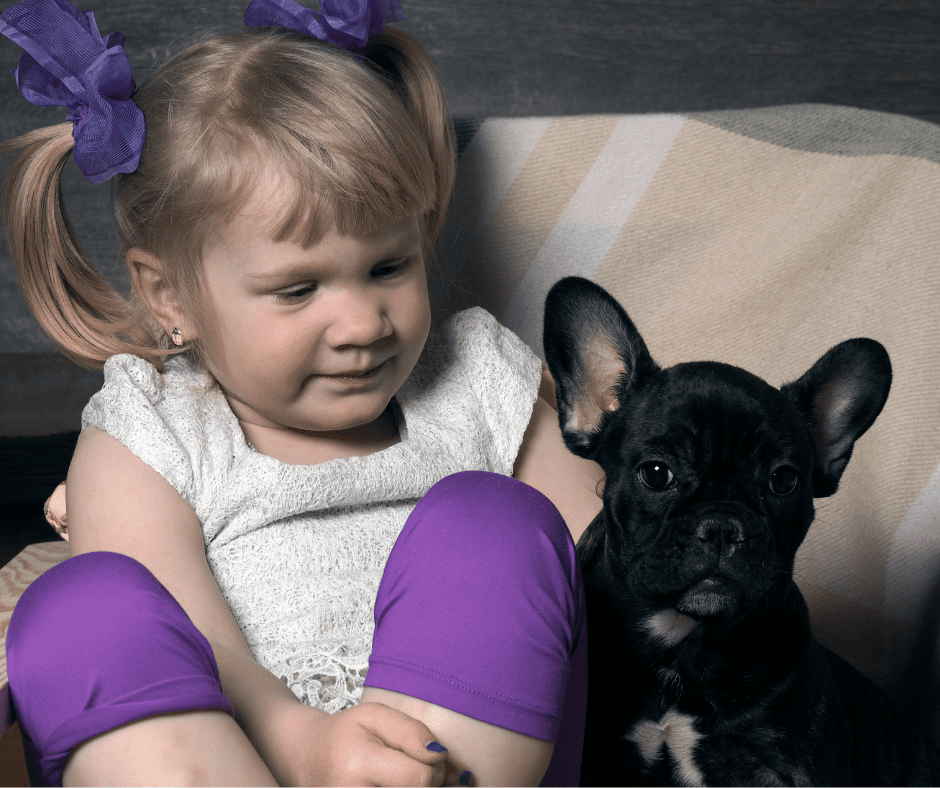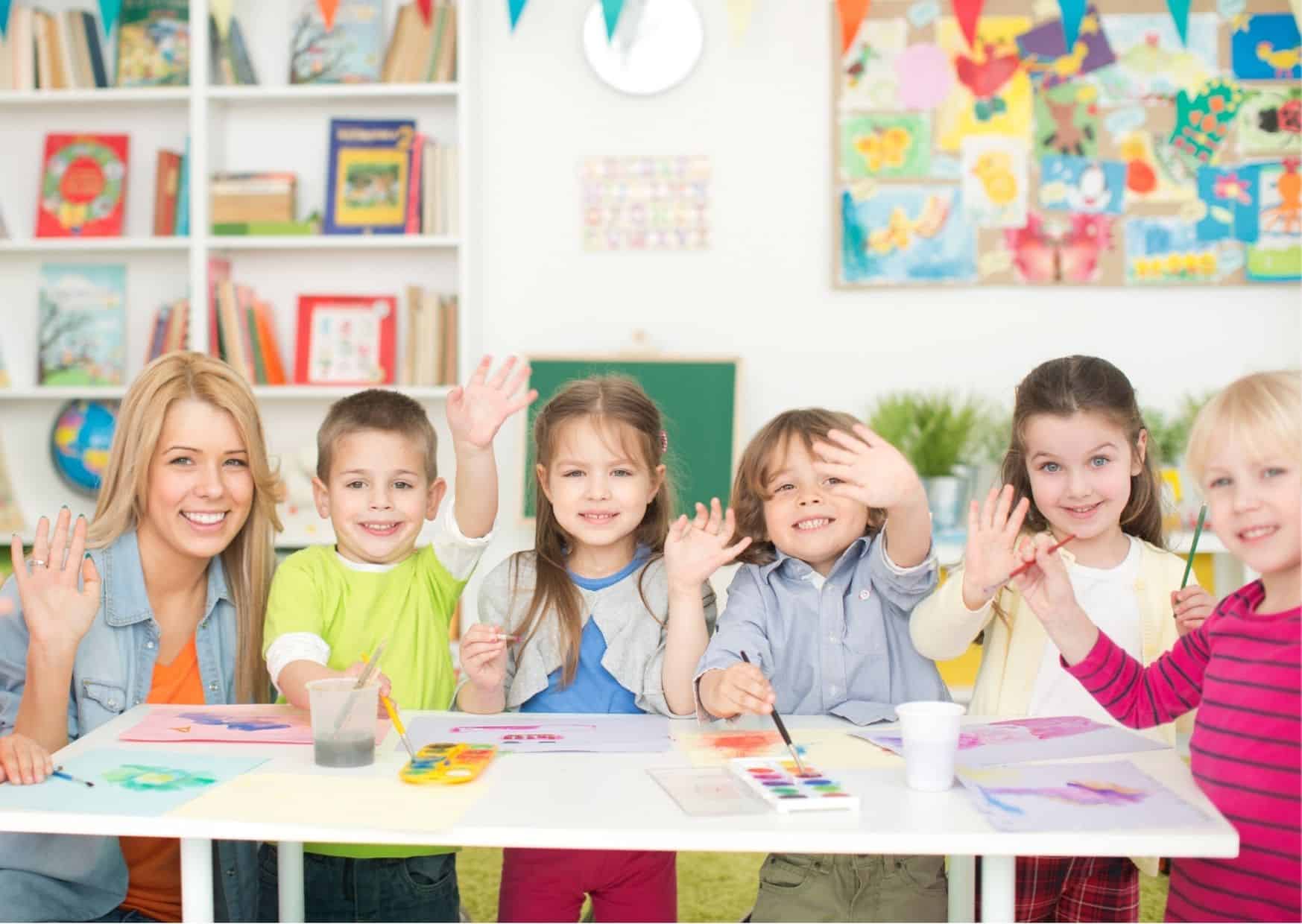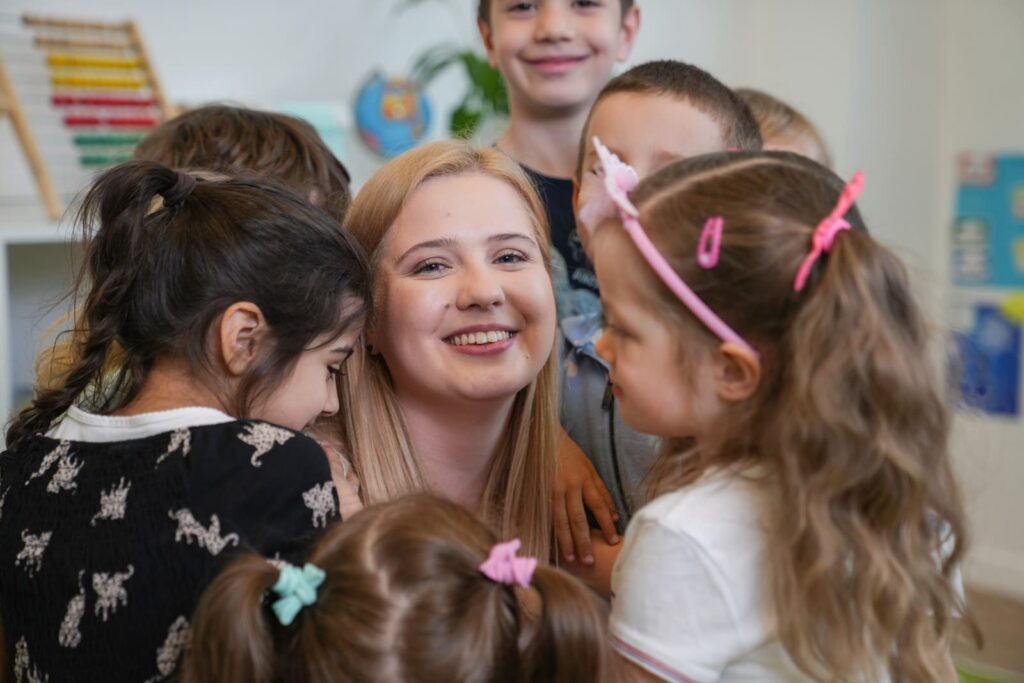Is a child and a dog under the same roof a good solution? What should parents pay attention to when they decide to have a pet? If you are looking for answers to these and similar questions - we invite you to read the interview with Maja Kochlewska, a veterinarian.
Orange Train Kindergarten: How to prepare a dog for the arrival of a new family member?
Maja Kochlewska (Veterinarian, graduated in veterinary medicine, from the age of 16 associated with rescue groups working with dogs, also conducting classes with children on the subject of safety, cooperating with the Great Orchestra of Christmas Charity as a volunteer of the Peace Patrol and first aid instructor): Like most changes in your pet's life, preparing your dog for a baby should be done gradually.
If, for example, the dog is sleeping with us in bed and we plan to change it - start moving it in small steps, several months in advance. Moving the bed beside the bed and encouraging the dog to come down, sleep separately. There are no contraindications for the animal still sleeping in the room, unless we ultimately want it to sleep outside of it - then the bed should be gradually moved, giving the dog the opportunity to contact us and be close to us.
An important element is the introduction of children's accessories so that the dog can get used to them. Let him sniff the new object, get acquainted with, for example, the child's bed. If he is anxious - go with him, touch the new, praise him when he comes.
It is worth teaching the pet from the very beginning that the time for play, walk or other entertainment is determined by us. Give him specific commands signaling the beginning and end of activity. The arrival of a child should not mean a sudden limitation of canine entertainment, nor its complete exclusion. Thus, it is advisable to distinguish between children's toys and dogs. If we teach the dog that a child's toys are not for him, and in turn, teach the child not to take his toys from the dog - we will reduce the risk of territorial behavior (defending the toy against the child) on the part of the pet.
When the baby arrives, help the dog to get used to it, so that the dog gets to know the smell of the baby before bringing it home. How to do it? For example, you can give your dog a scarf that smells like a baby (or anything else that the baby has already had contact with) and put it next to his bedding.
What should a dog's first contact with a child look like?
Holding the baby in our arms, let the dog calmly approach us. Let's crouch, sit down to lower ourselves to the height of the animal. In a calm, pleasant tone, let's praise the dog for approaching the baby, let him sniff it, even if the baby is licked as a result - it's nothing terrible, the dog's saliva contains, among others substances with antibacterial properties, so as long as we care for the hygiene of the pet's oral cavity - there is no reason to worry. Let us pet and praise the dog when it is near the child and behaving calmly.
By the way, a note about the dog's stroking itself - patting the head or neck is not perceived by the dog as a praise, but more as a discipline, due to the fact that in dogs' communication it means domination. It is better to stroke our four-legged friend on the side of the head, on the chin, on the side of the chest, under the ears (as long as the ears are not inflamed and it does not hurt him), or even on the lumbosacral spine.
What can a dog teach a child? How does it arouse his curiosity?
Contact with a dog makes it easier for a child to become aware of the strength of his own movements and learn to be gentle. Of course, it is of great importance here that the parent explains to the child how to handle the dog. The dog also helps to learn sensitivity and empathy, to understand the needs of other creatures. Close contact with an animal helps to learn the basics of proper bond building and safe interaction with others.
Following the dog also encourages the child to explore the world more widely, and thus arouses his interest in reality.
Working with a dog, training new skills, walks also teach responsibility and patience, working out the desired effect requires learning self-control and peace.
The dog sends out signals that it wants to play and warning signals that it wants to be alone. How to recognize his needs?
Dog's encouragement to play is usually easy to read. The most obvious is to bring the toy and demand attention by nudging or barking. An encouraging play dog may also assume a position with the forelegs lowered, often with the rear elevated. However, it is more difficult for us to understand the signals with which the animal tries to express its reluctance to a given type of interaction.
Let me start by reminding you never to leave your child alone with your dog. How much we would not trust our pet, not understanding the messages sent by the dog can end up tragically for the child. Responsibility for the bite and showing aggression by the animal is borne by ourselves and our failure to respect the boundaries communicated by the animal. The safety of your child and dog should be paramount to us.
However, usually before a dog bites, it sends out numerous warning messages. These are calming signals, which should be read as signs of the animal's discomfort. Contrary to appearances, these are signals that we ourselves send out often, and through which we subconsciously try to calm down.
The most subtle of the group of signals known as soothing are yawning, clapping, licking, or the so-called. Grooming - cleaning, scratching. Translated into verbal language, it is more or less "something is wrong, I feel anxious, I don't feel completely comfortable". Failure to react to the above messages will be visible when the animal moves its head away, moves away, tries to escape. The dog's final warning is a growling, possibly teeth snapping in the air.
If we still do not provide the dog with comfort and a sense of security - it may feel so threatened that it will bite. It is rare for a dog to attack without warning, and most often if it does, it is because of a prior experience of not responding to signals.
Remember to teach children to understand and respond to the above messages. We teach the youngest not to take away the dog's toys, not to play with its bowl. Letting your baby feed your pet is most helpful for building their relationship. However, it is important that the toddler does not do the same, but always in the presence and help of an adult. Help children understand their pet's needs and explain where their comfort zone begins and ends.
We teach children to touch gently - stroking instead of pinching or pulling the fur. As mentioned before, it's best to stroke the dog on the side of the dog's mouth, on the chin, on the side of the neck and chest, along the spine, but not on the back of the neck or on the head. Dogs also like to be petted on the upper abdomen, but showing the belly requires a lot of confidence and a sense of comfort on the part of the animal.
During walks, remind children to always ask the owner of another dog for permission to approach and stroke them. Let us also observe this ourselves. Even if the dog likes to interact with people, it may be working or learning new commands at any given moment. Let's not make it difficult for him.
What if there are already children at home and we are planning to have a dog?
When we want to bring a dog home with children, it is important to explain to the youngest what the animal needs and how to care for them. Until the age of 14, a child should not take care of an animal on its own and should not take full responsibility for it. Costs related to the maintenance, treatment and care of a pet are only part of the parent's tasks. Due to the safety of both the child and the dog - walks, training and games should be supervised by an adult.
Keep in mind that raising a dog is a big responsibility and it is not okay to pass it on to your child completely.
Due to the amount of attention an animal needs at the time of bringing into a new home, it is worth that the children are old enough to be able to cooperate with them in caring for them.
Before the dog arrives at home, it is important that you explain to the children that the dog's bedding is not a place to play, so that he can have a safe place to go away. Explaining to children how house rules will change with the arrival of a new pet is key to a safe and comfortable relationship.
Taking a new pet should not be treated as a gift or a surprise, but as a conscious, well-thought-out, jointly analyzed decision. All household members should be aware of the responsibilities they undertake and the challenges that await them.
thank you for the conversation
Orange Train Kindergarten: How to prepare a dog for the arrival of a new family member?
Maja Kochlewska (Veterinarian, graduated in veterinary medicine, from the age of 16 associated with rescue groups working with dogs, also conducting classes with children on the subject of safety, cooperating with the Great Orchestra of Christmas Charity as a volunteer of the Peace Patrol and first aid instructor): Like most changes in your pet's life, preparing your dog for a baby should be done gradually.
If, for example, the dog is sleeping with us in bed and we plan to change it - start moving it in small steps, several months in advance. Moving the bed beside the bed and encouraging the dog to come down, sleep separately. There are no contraindications for the animal still sleeping in the room, unless we ultimately want it to sleep outside of it - then the bed should be gradually moved, giving the dog the opportunity to contact us and be close to us.
An important element is the introduction of children's accessories so that the dog can get used to them. Let him sniff the new object, get acquainted with, for example, the child's bed. If he is anxious - go with him, touch the new, praise him when he comes.
It is worth teaching the pet from the very beginning that the time for play, walk or other entertainment is determined by us. Give him specific commands signaling the beginning and end of activity. The arrival of a child should not mean a sudden limitation of canine entertainment, nor its complete exclusion. Thus, it is advisable to distinguish between children's toys and dogs. If we teach the dog that a child's toys are not for him, and in turn, teach the child not to take his toys from the dog - we will reduce the risk of territorial behavior (defending the toy against the child) on the part of the pet.
When the baby arrives, help the dog to get used to it, so that the dog gets to know the smell of the baby before bringing it home. How to do it? For example, you can give your dog a scarf that smells like a baby (or anything else that the baby has already had contact with) and put it next to his bedding.
What should a dog's first contact with a child look like?
Holding the baby in our arms, let the dog calmly approach us. Let's crouch, sit down to lower ourselves to the height of the animal. In a calm, pleasant tone, let's praise the dog for approaching the baby, let him sniff it, even if the baby is licked as a result - it's nothing terrible, the dog's saliva contains, among others substances with antibacterial properties, so as long as we care for the hygiene of the pet's oral cavity - there is no reason to worry. Let us pet and praise the dog when it is near the child and behaving calmly.
By the way, a note about the dog's stroking itself - patting the head or neck is not perceived by the dog as a praise, but more as a discipline, due to the fact that in dogs' communication it means domination. It is better to stroke our four-legged friend on the side of the head, on the chin, on the side of the chest, under the ears (as long as the ears are not inflamed and it does not hurt him), or even on the lumbosacral spine.
What can a dog teach a child? How does it arouse his curiosity?
Contact with a dog makes it easier for a child to become aware of the strength of his own movements and learn to be gentle. Of course, it is of great importance here that the parent explains to the child how to handle the dog. The dog also helps to learn sensitivity and empathy, to understand the needs of other creatures. Close contact with an animal helps to learn the basics of proper bond building and safe interaction with others.
Following the dog also encourages the child to explore the world more widely, and thus arouses his interest in reality.
Working with a dog, training new skills, walks also teach responsibility and patience, working out the desired effect requires learning self-control and peace.
The dog sends out signals that it wants to play and warning signals that it wants to be alone. How to recognize his needs?
Dog's encouragement to play is usually easy to read. The most obvious is to bring the toy and demand attention by nudging or barking. An encouraging play dog may also assume a position with the forelegs lowered, often with the rear elevated. However, it is more difficult for us to understand the signals with which the animal tries to express its reluctance to a given type of interaction.
Let me start by reminding you never to leave your child alone with your dog. How much we would not trust our pet, not understanding the messages sent by the dog can end up tragically for the child. Responsibility for the bite and showing aggression by the animal is borne by ourselves and our failure to respect the boundaries communicated by the animal. The safety of your child and dog should be paramount to us.
However, usually before a dog bites, it sends out numerous warning messages. These are calming signals, which should be read as signs of the animal's discomfort. Contrary to appearances, these are signals that we ourselves send out often, and through which we subconsciously try to calm down.
The most subtle of the group of signals known as soothing are yawning, clapping, licking, or the so-called. Grooming - cleaning, scratching. Translated into verbal language, it is more or less "something is wrong, I feel anxious, I don't feel completely comfortable". Failure to react to the above messages will be visible when the animal moves its head away, moves away, tries to escape. The dog's final warning is a growling, possibly teeth snapping in the air.
If we still do not provide the dog with comfort and a sense of security - it may feel so threatened that it will bite. It is rare for a dog to attack without warning, and most often if it does, it is because of a prior experience of not responding to signals.
Remember to teach children to understand and respond to the above messages. We teach the youngest not to take away the dog's toys, not to play with its bowl. Letting your baby feed your pet is most helpful for building their relationship. However, it is important that the toddler does not do the same, but always in the presence and help of an adult. Help children understand their pet's needs and explain where their comfort zone begins and ends.
We teach children to touch gently - stroking instead of pinching or pulling the fur. As mentioned before, it's best to stroke the dog on the side of the dog's mouth, on the chin, on the side of the neck and chest, along the spine, but not on the back of the neck or on the head. Dogs also like to be petted on the upper abdomen, but showing the belly requires a lot of confidence and a sense of comfort on the part of the animal.
During walks, remind children to always ask the owner of another dog for permission to approach and stroke them. Let us also observe this ourselves. Even if the dog likes to interact with people, it may be working or learning new commands at any given moment. Let's not make it difficult for him.
What if there are already children at home and we are planning to have a dog?
When we want to bring a dog home with children, it is important to explain to the youngest what the animal needs and how to care for them. Until the age of 14, a child should not take care of an animal on its own and should not take full responsibility for it. Costs related to the maintenance, treatment and care of a pet are only part of the parent's tasks. Due to the safety of both the child and the dog - walks, training and games should be supervised by an adult.
Keep in mind that raising a dog is a big responsibility and it is not okay to pass it on to your child completely.
Due to the amount of attention an animal needs at the time of bringing into a new home, it is worth that the children are old enough to be able to cooperate with them in caring for them.
Before the dog arrives at home, it is important that you explain to the children that the dog's bedding is not a place to play, so that he can have a safe place to go away. Explaining to children how house rules will change with the arrival of a new pet is key to a safe and comfortable relationship.
Taking a new pet should not be treated as a gift or a surprise, but as a conscious, well-thought-out, jointly analyzed decision. All household members should be aware of the responsibilities they undertake and the challenges that await them.
thank you for the conversation




